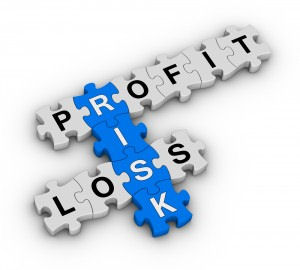Modern Portfolio Theory is for Nitiots
December 20, 2012
By Jack Sparrow
In the following paragraphs, we shall defend the assertion that Modern Portfolio Theory is for Nitiots.
To begin, let us define our terms:
Modern Portfolio Theory (via investopedia): “A theory on how risk averse investors can construct portfolios to optimize or maximize expected return based on a given level of market risk, emphasizing that risk is an inherent part of higher reward.”
Nit: In poker parlance, an über-conservative player who constantly folds and only enters pots with “premium” hands.
Nitiot: The player who is so fearful of risk, he (or she) will make terrible decisions to avoid it – laboring under the mistaken assumption that volatility and risk are the same thing.
At the poker table, the Nitiot plays timidly as a rule, which creates two bad results: 1) the tendency to get pushed out of pots, and 2) the inability to get paid off with premium hands (because the rare display of strength sticks out like a sore thumb).
In markets, the Nitiot makes supposedly “conservative” decisions — guided by the conventional wisdom of MPT — and often winds up poorer for their efforts.
The Nitiot’s central failing is also a central plank of Modern Portfolio Theory: The wrong-headed notion that volatility equates to risk.
In contrast to what ivory tower types and passive investors believe, winning poker players, winning traders and winning investors all have something in common: They understand that the presence of volatility means opportunity, not risk — so long as it is handled in the proper context.
John Maynard Keynes (no slouch of a trader himself) put it simply:
“It is largely the fluctuations which throw up the bargains and the uncertainty due to fluctuations which prevents other people from taking advantage of them.”
Warren Buffett — a value investor who knows a thing or two about markets — further agrees with his mentor, Ben Graham, that risk is the potential forpermanent capital loss, which has no necessary correlation to volatility at all.
Which market environment was “riskier,” for instance, from a value investor’s perspective: March 2007, when volatility was at rock-bottom lows with market valuations sky high… or March 2009 (the nadir of the global financial crisis) when conditions were exactly reversed?
Or, to illustrate it in poker terms:
You are in a deep-stacked No Limit Texas Hold ‘Em poker game. You call a multiway $500 preflop raise with the Ace-King of hearts. The flop comes Q-J-T of hearts. Your first opponent bets $2,000. Your second opponent raises to $5,000, dramatically increasing the volatility of the hand.You have a royal flush – the ultimate nuts. Has the presence of volatility somehow increased your risk? Are you supposed to be unhappy about this?
All truly robust (long-term profitable) poker, trading and investing strategies must endure “drawdowns” — periods of adverse volatility excursion, i.e. dips and troughs in the equity curve. The strategies that appear to be flawless (drawdown free) wind up being Ponzi schemes, blow-ups in waiting, or both. (Investors in the Bear Stearns High Grade Structured Credit Strategies Enhanced Master Fund — try saying that three times fast! — saw silky-smooth returns of 1% per month for +40 months in a row before it all went kablooey.)
In a strange way, then, the presence of equity curve volatility (and carefully managed drawdowns) can actually be a positive, to the degree that survival signals robustness. A methodology that undergoes routine “stress testing,” yet continues to grind out new equity highs, is far more desirable than a “perfect” methodology that has never been tested at all.
What’s more, as Keynes alluded earlier, the presence of volatility in and of itself creates opportunity, via the ability to make superior decisions.
Why? Because trading and investing, like poker, are minus sum games. It is statistically impossible for a majority to outperform (though a majority can certainly underperform), and everyone pays the vigorish (slippage, commissions, rake and tokes etc).
In a minus sum game, the winner must have an “edge” over his or her collective opponents — a means of making superior decisions (higher expected value decisions) consistently over time.
Volatility thus creates opportunity not just by throwing up bargains, as Keynes suggested, but also by highlighting skill differentials: In a volatile environment, the less-skilled are more likely to make mistakes than the highly skilled. These mistakes, on balance, transfer profit from one group to another.
On a related point, for the trader or investor who wishes to improve, the only way to close this skill gap is by enduring volatility and learning how to handle it. (As the saying goes: “A calm sea never made a skilled mariner.”)
But getting back to Nitiots: On top of wrongly equating volatility with risk, these folks make an even nuttier mistake. The MPT Nitiot assumes skill has no bearing on outcome… perhaps the most fool-headed assumption academia has ever put forth!
According to these goofballs, factors like asset valuation, supply and demand, entry and exit prices, and basic risk management — all of which require skill to assess — don’t matter to the process at all. All that stuff is skipped in favor of “asset allocation,” where the chief decision is whether to (passively) accept a mix of 60 percent equities, 40 percent bonds or what have you.
This ivory tower nonsense was popularized in a 1985 book by Charles Ellis titled “Investment Policy: How to Win the Loser’s Game.” According to Nitiots, the way to win the “loser’s game” is not to become a winner yourself (by studying other winners and developing a skillset)… it’s to pretend skill is somehow irrelevantand choose to play the game blindfolded!
But it gets worse, oh yes…
In the futures trading biz, all money managers are forced to prominently disclose that “PAST PERFORMANCE DOES NOT GUARANTEE FUTURE RESULTS.” And yet this is exactly the crumbling edifice that Modern Portfolio Theory is built on — the dangerous notion that the future (in terms of asset class performance) will look reliably like the past.
MPT advocates love to cite long term studies — the “Ibbotson Study” one of the most popular — as justification for both their passive market approach and optimistic assumptions as to future stock and bond returns. In other words: The blindfold method worked great for the last X decades, so why not expect more of the same?
The trouble with this is sheer lack of sample size. From a statistical validity perspective, the 20th century — a period of unprecedented USA prosperity — offers a sample size of one!
Will the next twenty-five year period look just like the last one, in which we saw the build-up of a “debt supercycle” alongside one of the greatest equity bull runs of all time? There is ample reason to believe it won’t be the same at all… and while passive investing Nitiots “hope” it will, is hope really a strategy?
Blatant dismissal of valuation — whether an investment is high or low priced relative to historic benchmarks, cash flows etcetera — is another serious issue. For example: According to MPT logic, US real estate was just as attractive an asset class in late 2006 / early 2007 (near the peak of the housing bubble) as at any other time — or perhaps even more so, because the track record of rising home prices was longer!
As for the fact that housing bubble warning signs (remember condoflip.com?) and countless valuation metrics (price-to-rent, rent-to-income, LTV ratios, the California 50-year mortgage) had gone Screaming Mimi vertical? Meh… such counted as skill-based assessment, and was thus completely ignored.
MPT valuation blindness, and its follow-on gross overexposure to uber-crowded areas such as private equity, was a big reason many university endowment funds plunged into the abyss in 2008. The Nitiots thought they were being prudent, while inhaling risk by the lungful!
Meanwhile, as of this writing, MPTers are setting up their portfolios for another valuation-based massacre, this time in “safe” government bonds. To borrow a James Grant quip, US Treasuries have migrated from “risk free return” to “return free risk.” But once again, such an assessment is skill based… requiring the ability to turn one’s head and see the freight train coming down the track… and thus for Nitiots not allowed.
Modern Portfolio Theory has yet another, more cynical element in our view. It is a tool used to sucker the hapless retirement investor.
Most skill contests are understood to be dangerous, in respect to adverse consequences if you don’t know what you are doing. If a novice sits down at a high stakes poker game, or opens up a futures trading account, and proceeds to get educated at the cost of all his dough, few will feel sympathy. “You pays your money and you takes your chances.”
But when it comes to retirement investing, tens of millions of Americans — and tens of millions in other countries too — have little choice in the matter. By dint of amassing a pool of savings to live on in old age, these individuals, who may have never analyzed a stock or bond in their lives, with no desire to start now, are nonetheless forced to “sit down at the table” that is markets. It is either that, or see their purchasing power cruelly eaten away by the ravages of inflation.
For Wall Street, this gigantic pool of forced retirement savings creates a juicy dilemma. There are nowhere near enough truly skilled managers to run all that money properly… but there is plenty of incentive to run it poorly!
Of course, you can’t admit to Mr. and Mrs. Pensioner that your plan is to toss their savings into the maw of a faceless, bloated, fee-generating mediocrity machine. So instead, you explain to them why skill doesn’t actually matter… why “asset allocation” is the holy grail… why stocks always go up “in the long run” and so on… thus making Amalgamated Juggernaut Advisors the best choice.
Modern Portfolio Theory is wonderfully enabling for all this, emphasizing, as it does, the mass allocation of gigantic sums in robotic fashion, as if skill (and maneuverability) did not matter at all.
In a final word to MPT Nitiots, we offer the perspective of Robert L. Bacon, author of the 1956 classic “Secrets of Professional Turf Betting:”
I don’t want to be like Pittsburgh Phil and win a million dollars at the races. I’d just like to grind out $25 a day for myself without any risk!How many times have you heard something like that from turf fans who were trying to be “conservative” at racing? …Oh Brother! You can add this “grind” idea to the long list of other unsound notions held by the public play…. One sure thing that a smart player engraves deeply into his skull, is the fact that you MUST speculate at the races. You CAN’T grind!The player at the races can’t grind or chisel because [that girl] is taken. The racetrack has all grind and chisel privileges! The mutuel take and the breakage add up to a percentage that continually grinds and chisels the betting money… The grind privileges are spoken for and taken, so the professional bettor must speculate. The mutuel grinding only goes one way – against the bettor. But any percentage can be overcome by enough winners at fat enough prices!Fortune favors the speculator over the grinder because of the plain old arithmetical percentages. The speculator has a percentage chance to win. The grinder has no chance.To beat the percentage of the mutuels, the player must ALWAYS have an overlay. He must always have an extra percentage in his favor, to counteract the “take” percentage. Forget about this idea of “grinding out a day’s pay.” If you want to make a day’s pay at the races, get a job watering horses, or pitching manure into trucks. But never try to grind it out of the mutuels.You Must Speculate — You CAN’T GRIND!
“Speculate” is a dirty word in conventional investment circles. But there is a difference between smart speculation and foolish speculation. We humbly suggest that trusting one’s savings to Modern Portfolio Theory – i.e. being a Nitiot – is the most foolish speculation of all.
http://www.mercenarytrader.com/




No comments:
Post a Comment